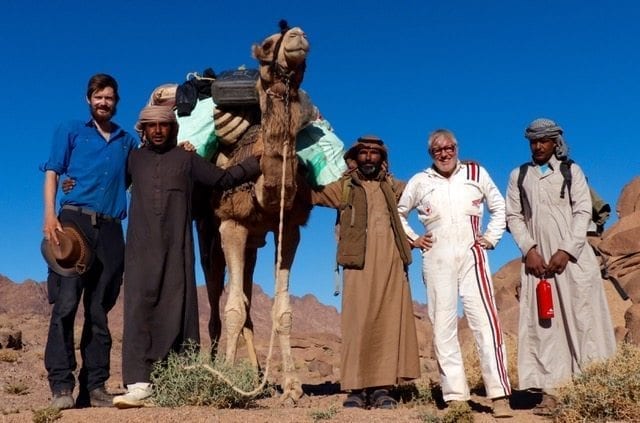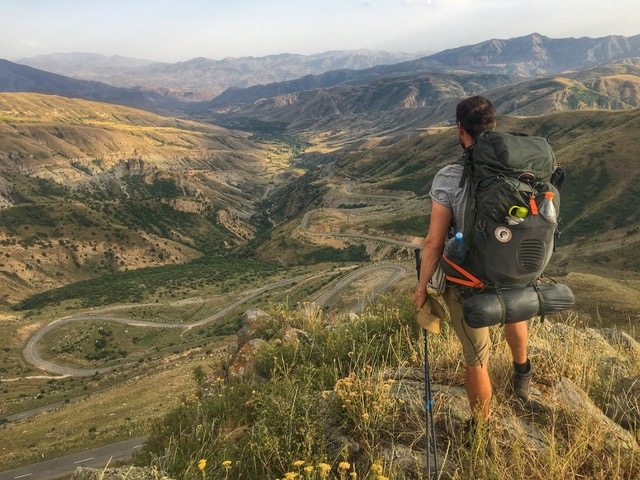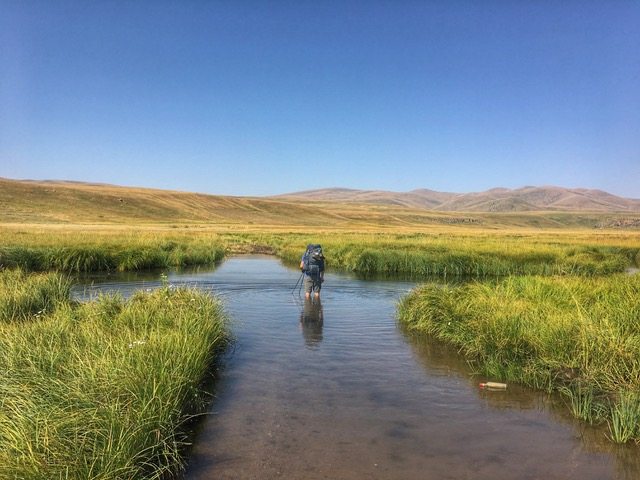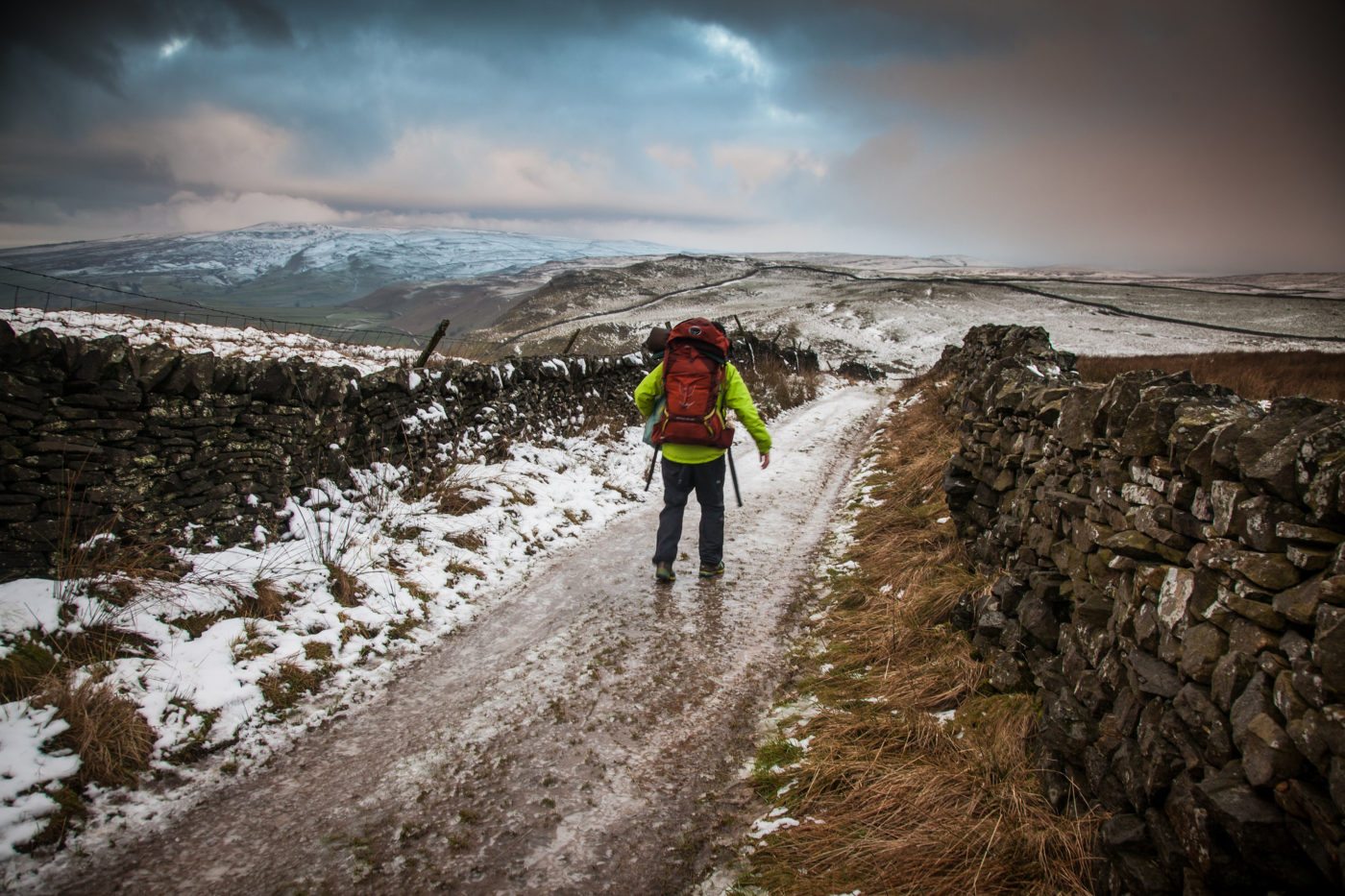A guest blog from Leon McCarron who has walked many thousands of miles on many expeditions. Leon’s new book, The Land Beyond, tells the story of walking 1000 miles from Jerusalem to Mount Sinai, through the heart of the Middle East. Read more here.

Walking is so wonderfully simple. For most of us, we don’t even have to think about it; we have done it almost every day since childhood and, thus, we are experts (and it’s always nice to be an expert at something, even something as simple as walking.)
We walk to keep fit, and to get fresh air. We walk to clear out heads (I find that my brain works best in tandem with my feet at 3mph) and we walk to think. At times we walk for fun, and at others we walk to get somewhere. With a good pair of boots and a comfy pack we can, theoretically, step out our front door and go (albeit slowly) just about anywhere we like. We can hop on and off public transport to pick up speed once in while, or we can disappear into the hills, unroll a sleeping bag and have a night under the stars; then, the next morning, lace those boots back up and do it all over again.
Increasingly, however, we live in a world that discourages us from standing on our own two feet. More people than ever before we commute by car, and in any public space where it’s even remotely feasibly, motorised walkways and escalators are created to allow us to move whilst standing still.
I am a huge fan of walking – not just for the reasons above, but also as a means of transport. The very slowness of it is the key – it creates a visceral and immersive experience. Over the last six years, I’ve walked upwards of seven thousand miles on a series of lengthy journeys. I think (and hope) that during that time I’ve developed a clear idea of how to plan a walking trip and so, if it appeals to you too, here is some basic advice to get you started:

Self-supported versus joining a group
To be self-supported means carrying all of your own equipment in a backpack and resupplying en route. This has always been my preferred method because it gives a great deal of freedom and encourages relative minimalism. I’ve always enjoyed the feeling of having everything I need to survive and thrive suspended on my back. The downside, however, is that those suspended belongings will always weight enough to cause some degree of pain and misery – sore shoulders, raw hips, aching back muscles (etc.) I recommend this approach, then, with a slight caveat – carry all of your own gear, but only if you’re content with the weight, especially over a long distance, and only if you’ve spent a decent amount of time on the packing process (see below.) Nothing ruins a trip like an overly heavy pack – I’ve learned that the hard way.
The other option is to join a group, where an organiser will be able to arrange for luggage to be carried along each day stage of the trip (you can also find ways to do this independently on busier trails such as the Camino de Santiago.) This has the benefit of making the walking easier, but you lose some independence and become reliant on others. This is probably best if you think you’ll have trouble with the weight, but otherwise I suggest taking the first suggestion, and learning how to pack like a pro.

What to pack
The headline for this as far as I’m concerned is – get the best boots and backpack that you can. That doesn’t necessarily mean the most expensive, but don’t scrimp either. Get the boots that fit best, and the pack that is most comfortable. I can’t emphasise this enough – you will regret it if either are sub-par.
Depending on where you’re going, you will probably want to take some camping gear. Aside from walking, the next biggest use of your time will be sleeping, so make sure you have a sleeping mat (preferably one that you’ve tried and tested and like) and use a sleeping bag that is rated to a temperature about 5C lower that you think you’ll actually experience. It’s awful being cold at night.
The rest, hopefully, is obvious – take a bivvy bag if you plan on staying lightweight and won’t get too much rain (a basha cover can help here too) and a tent if you want more all-weather protection. If you’re travelling with someone else, share a tent to spread out the weight (assuming you can stand the smell of each other’s feet.)
There’s always a compromise in weight versus comfort, but I’d err on the side of taking less than you need than taking more. Most things you can buy in most places.
When you’re packing, lay out everything you think you’ll need. Then try and remove as much of it as you can. Put it in the pack, and then try again. I do this two or three times until it feels like I’m really down to the bare minimum. Remember that once you start carrying food and water on the road, you’ll end up with much more weight than you have at home.
Some absolute rules – don’t take a laptop. I did last time, and it was awful (I was worried about breaking it, and it reminded me of work that I hadn’t done.) Unless this is part of your job, don’t take excessive amounts of camera or communications gear. If it’s your hobby, then you’ll be best placed to make the right judgement but, these days, even as someone who makes a living from this stuff, I only take my phone unless I’m actively making a film about a journey.
On the topic of phones – turn off data roaming, and try not to use wifi too often, even if it’s available. Walking should be about disconnecting. (Disclaimer – I sometimes use data and/or wifi to post cool pictures on Instagram. I hate myself for it, but I can’t help it. Embrace failure of principals once in a while too.)

For my last multi-week trip I took:
- 3 pairs of socks (2 heavy, 1 light)
- 2 pairs underpants (the second as a luxury for special occasions)
- 2 t-shirts
- fleece
- raincoat
- boots (and flipflops for evening)
- down jacket (for evenings)
- sleeping bag
- sleeping mat
- Pack and raincover
- Small stove, pan and spork (plus gas canister)
- Multitool
- Med kit and washbag
- Phone and cables
- Small solar panel
- Notebook
- Compass and Map
- Ziplock bags and drybag for electronics
- Hipflask of whisky

Where to go
There are endless options, of course, both locally and farther afield. A good place to start is by looking at trail systems. In the UK the West Highland Way, the South West Coastal Path and the Pennine Way are among the best known, and well designed to offer various options for distances per day and accommodation. The Camino de Santiago (either via the French or Portuguese variant) is a great starter trail, with cheap ‘pilgrim’ accommodation along the way and hundreds of other hikers to share the experience with. Europe is full of ‘GR’ routes which are well designed and maintained, and cover a variety of types and difficulty of terrain. This year I’ve also walked on trails in the Middle East, Armenia and the Balkans. Google ‘World’s Best Trails’ for some inspiration.
I suggest beginning locally if you are not a particularly experienced hiker. It will be cheaper, easier (at least logistically to begin) and a nice stepping stone to other adventures. Alternatively, if you have a lot of miles beneath your feet already, perhaps try blazing your own trail – choose a country, landscape, and go! Be wary of weather/water/other logistical concerns, and make sure you’ve done your due diligence. I generally make sure I know distances between food and water points, the general political/cultural state of the country, and whether I need to be anywhere at a certain point (and what implications that will have on my planning.) If you’ve researched those things, you’re probably ready to give it a go.

Miles per day
I think that 15 is the golden number although, like everything, it’s dependent on each individual. For a slow ramble with lots of stopping to smell the roses/drinking beer, 10 miles a day is sufficient. To really cover serious terrain and make progress on a trip, 20 is a good target. 15 gives a little of both. In the past I’ve tried to do long journeys averaging 25 or 30 miles a day but, beyond a slight massage of the ego in knowing it’s possible, it mostly seems counterintuitive – I end up walking faster and farther than I’d like, with little time to enjoy myself.
Where to sleep
I think every walking trip should involve at least some experience of sleeping outside; after all, one of the reasons we walk is to escape interiors. Different countries will have different regulations on where you can camp; in the UK, for example, it is mostly illegal to wild camp (Scotland is an exception, although even there it is not clear-cut.) That doesn’t mean you can’t do it, but you need to follow the ‘leave no trace’ principal, and choose your spot wise. Don’t sleep close to someone’s house, or on top of a farmer’s ploughed field, and certainly don’t go starting fires willy-nilly. In short – don’t be an asshole. If you follow that rule, you’re likely to be fine. Wild camping is the most fun of all the outdoor sleeping experiences, so do give it a go.
On longer journeys, or when the weather is awful, it can be nice to sleep inside once in a while. Remember – you don’t get extra adventure or macho points for being miserable; you just end up miserable. So if you’re cold and wet and want to sleep in a hostel or a pub, then do it. It’ll be great.

My final, general tip is this: allow yourself a little luxury. On my early journeys I was skint and stubborn, and refused to ever give in on my principals of frugality and asceticism. That was ridiculous. Now I carry some whisky for the evenings, and if I pass a good pub or Fish and Chip shop on my way, I’ll stop in. A little pampering once in a while helps during the harder times when the hills seem vertical and the rain is lashing down.
I hope this is helpful. If I had to summarise what I’ve learned, I’d probably do so like this: don’t let anything put you off. You do not need the best gear, or years of experience. You don’t need to start off with something epic, or to wait for your lame friends to finally commit to joining you. The beauty of walking is in the simplicity, so keep it simple, lace up your boots, and step out. Walk well, and let me know how it goes!
Leon’s new book, The Land Beyond, tells the story of walking 1000 miles from Jerusalem to Mount Sinai, through the heart of the Middle East. Read more here



Dear Leon McCarron, you have provided great info in a very simple and honest manner,I am from Lahore,Pakistan,after reading your blog I feel more confident and in near future I will attempt a 15 miler to start with,Thanks,
WORLD IS YOUR
A hip flask of Whiskey might be a bit small for some. A cheeky couple of nips is the reward for the long day of hiking.
Sounds ultra adventurous!